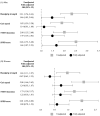Association between number of functional teeth and physical function among community-dwelling older adults: Korean Frailty and Aging Cohort Study
- PMID: 39707218
- PMCID: PMC11660504
- DOI: 10.1186/s12877-024-05585-y
Association between number of functional teeth and physical function among community-dwelling older adults: Korean Frailty and Aging Cohort Study
Abstract
Background: Functional teeth are important for maintaining appropriate masticatory function and nutritional intake, affecting physical function in older adults. This study aimed to evaluate the association between number of functional teeth and physical function in community-dwelling older Korean adults.
Methods: This cross-sectional study was conducted among a total of 2,527 participants (mean age, 76.5 ± 3.9; 53.4% women) who were enrolled in the Korean Frailty and Aging Cohort Study (2016-2017). Participants were categorized based on the number of functional teeth into two groups: < 20 and ≥ 20 functional teeth. Functional teeth were defined as the remaining natural teeth with visible crowns, with or without restorations, prosthetic pontics, or dental implants on panoramic radiography. Physical function was assessed using handgrip strength, gait speed, five-times sit-to-stand test (5TSTS) duration, and the Short Physical Performance Battery (SPPB) score. Multivariate linear and logistic regression models were used to evaluate the association between number of functional teeth and physical function.
Results: Of all the participants, 869 (34.3%) had < 20 functional teeth. After full adjustment for sociodemographic factors, lifestyle, health condition, and oral health, an increase in one functional tooth was associated with a corresponding increase in gait speed (men: B = 0.002, p = 0.032; women: B = 0.002, p = 0.013) and SPPB (men: B = 0.019, p < 0.001; women: B = 0.018, p < 0.001) in both men and women. The time taken for the 5TSTS was shorter for an increase in one more functional tooth (men, B=-0.033, p = 0.006; women, B=-0.036, p = 0.021) in both men and women. An increase in one functional tooth was associated with a corresponding increase in handgrip strength only in men (men, B = 0.049, p = 0.009; women, B=-0.003, p = 0.814). The associations between < 20 functional teeth and low handgrip strength [odds ratio (OR) = 1.46, 95% confidence interval (CI): 1.03-2.06], long 5TSTS duration (OR = 1.47, 95% CI: 1.07-2.02), and low SPPB scores (OR = 1.64, 95% CI: 1.07-2.53) were significant in fully adjusted model compared with ≥ 20 functional teeth only in men.
Conclusions: Fewer functional teeth were associated with low physical function in older adults. Our results emphasize the importance of maintaining adequate functional teeth to preserve physical function in community-dwelling older adults.
Keywords: Functional teeth; Older adults; Physical function.
© 2024. The Author(s).
Conflict of interest statement
Declarations. Ethics approval and consent to participate: Ethical approval for the KFACS protocol was obtained from the Clinical Research Ethics Committee of Kyung Hee University (Institutional Review Board [IRB] number: 2015-12-103). The current investigation was deemed exempt from further review by the Clinical Research Ethics Committee of Kyung Hee University Medical Center (IRB number: 2024-08-011), which was conducted in compliance with the guidelines of the Declaration of Helsinki. All participants provided written informed consent. Consent for publication: Not applicable. Competing interests: The authors declare no competing interests.
Figures


Similar articles
-
Assessment of Gait Parameters Using Wearable Sensors and Their Association With Muscle Mass, Strength, and Physical Performance in Korean Older Adults: Cross-Sectional Study.JMIR Form Res. 2025 Apr 10;9:e63928. doi: 10.2196/63928. JMIR Form Res. 2025. PMID: 40209209 Free PMC article.
-
Nutritional risk and its relationship with physical function in community-dwelling older adults.Aging Clin Exp Res. 2022 Sep;34(9):2031-2039. doi: 10.1007/s40520-022-02171-3. Epub 2022 Jul 1. Aging Clin Exp Res. 2022. PMID: 35773448 Free PMC article.
-
Nutritional status and physical performance using handgrip and SPPB tests in hospitalized older adults.Clin Nutr. 2021 Nov;40(11):5547-5555. doi: 10.1016/j.clnu.2021.09.034. Epub 2021 Sep 25. Clin Nutr. 2021. PMID: 34656951
-
Oral frailty as a risk factor for mild cognitive impairment in community-dwelling older adults: Kashiwa study.Exp Gerontol. 2023 Feb;172:112075. doi: 10.1016/j.exger.2022.112075. Epub 2022 Dec 26. Exp Gerontol. 2023. PMID: 36581224 Review.
-
The association between the number of teeth and frailty among older adults: a systematic review and meta-analysis.Aging Clin Exp Res. 2025 May 16;37(1):156. doi: 10.1007/s40520-025-03053-0. Aging Clin Exp Res. 2025. PMID: 40377807 Free PMC article.
Cited by
-
Epidemiology of oral health in older adults aged 65 or over: prevalence, risk factors and prevention.Aging Clin Exp Res. 2025 Jun 23;37(1):193. doi: 10.1007/s40520-025-03110-8. Aging Clin Exp Res. 2025. PMID: 40549221 Free PMC article. Review.
References
MeSH terms
Grants and funding
LinkOut - more resources
Full Text Sources

